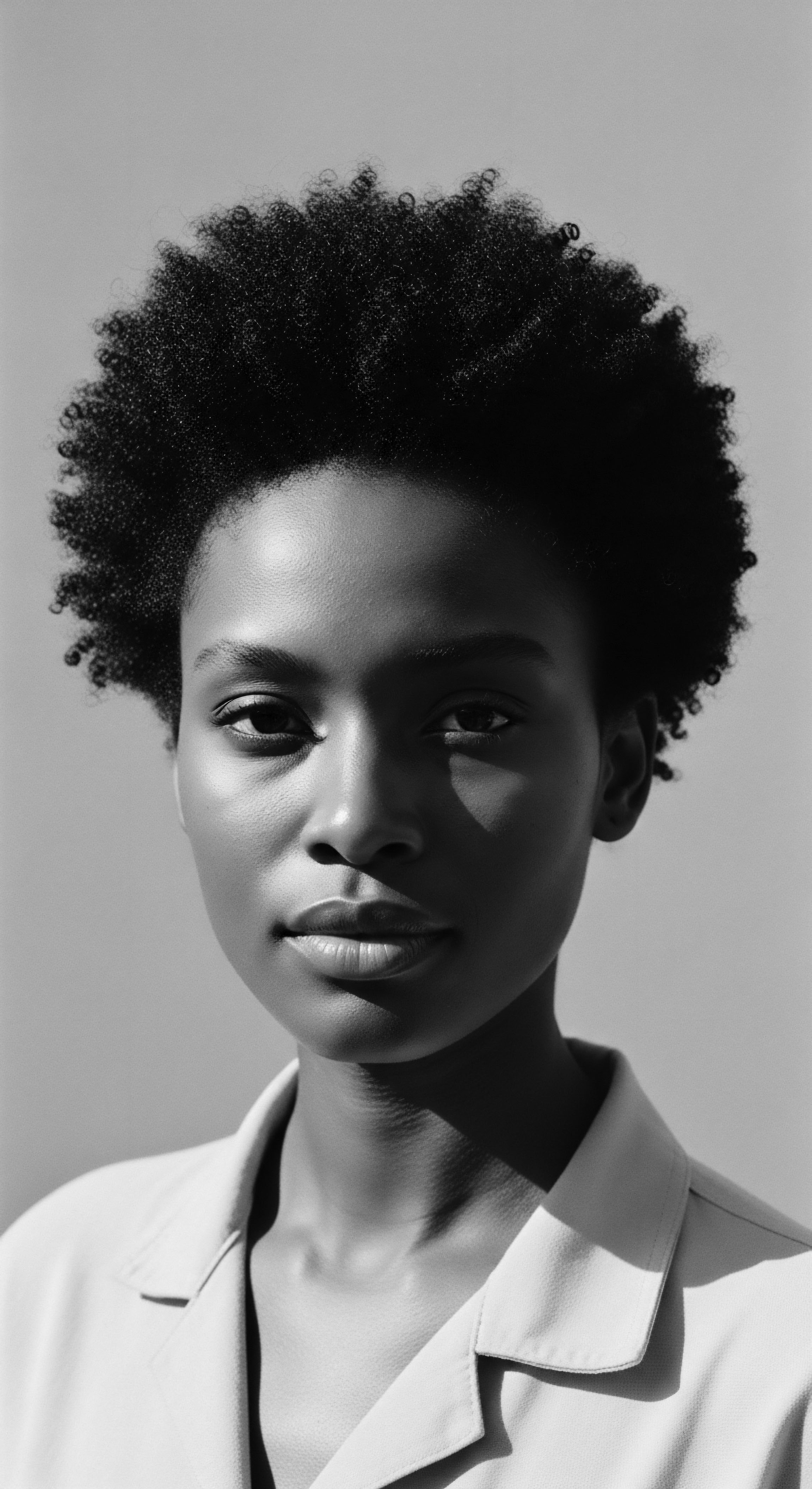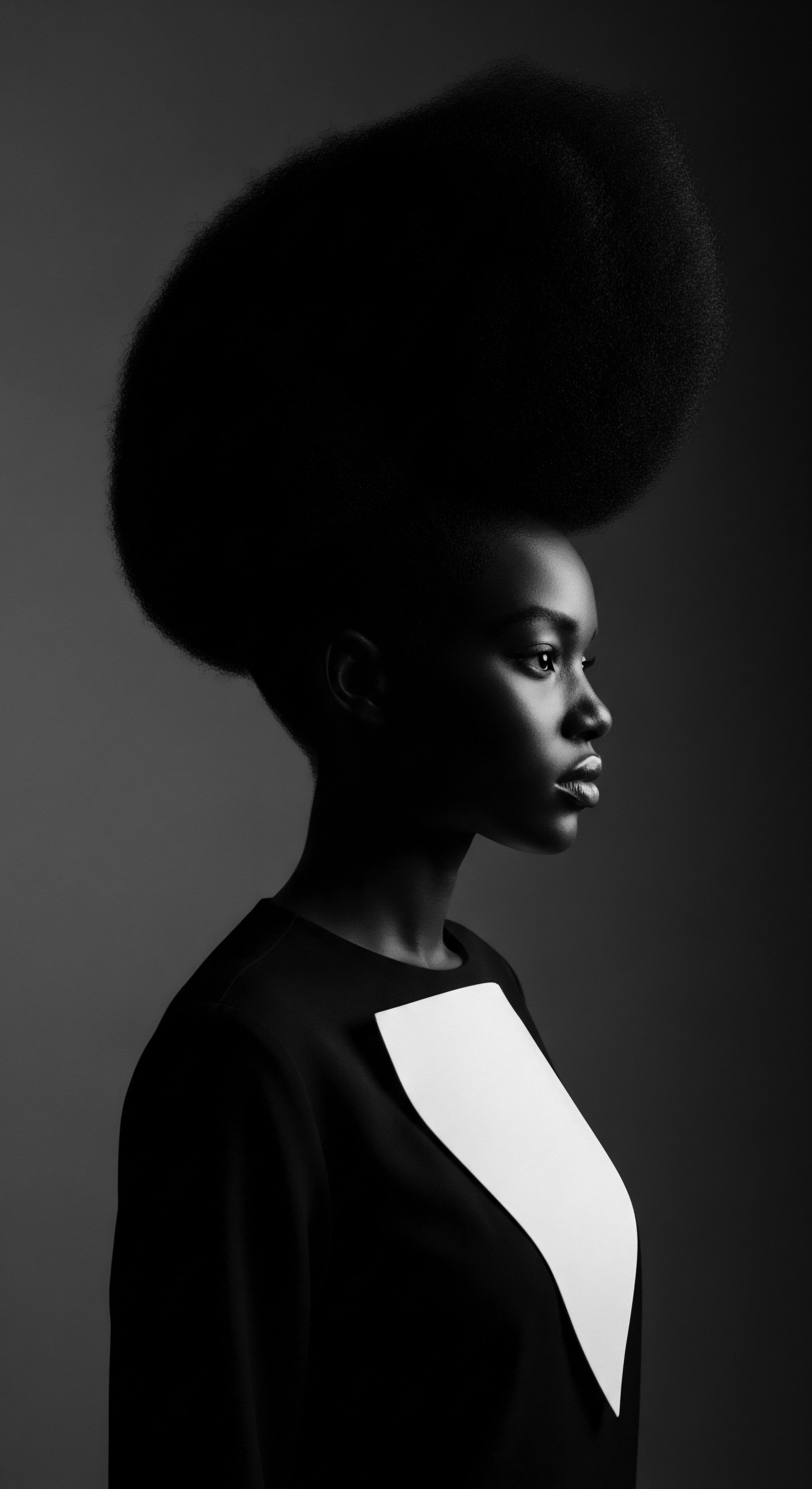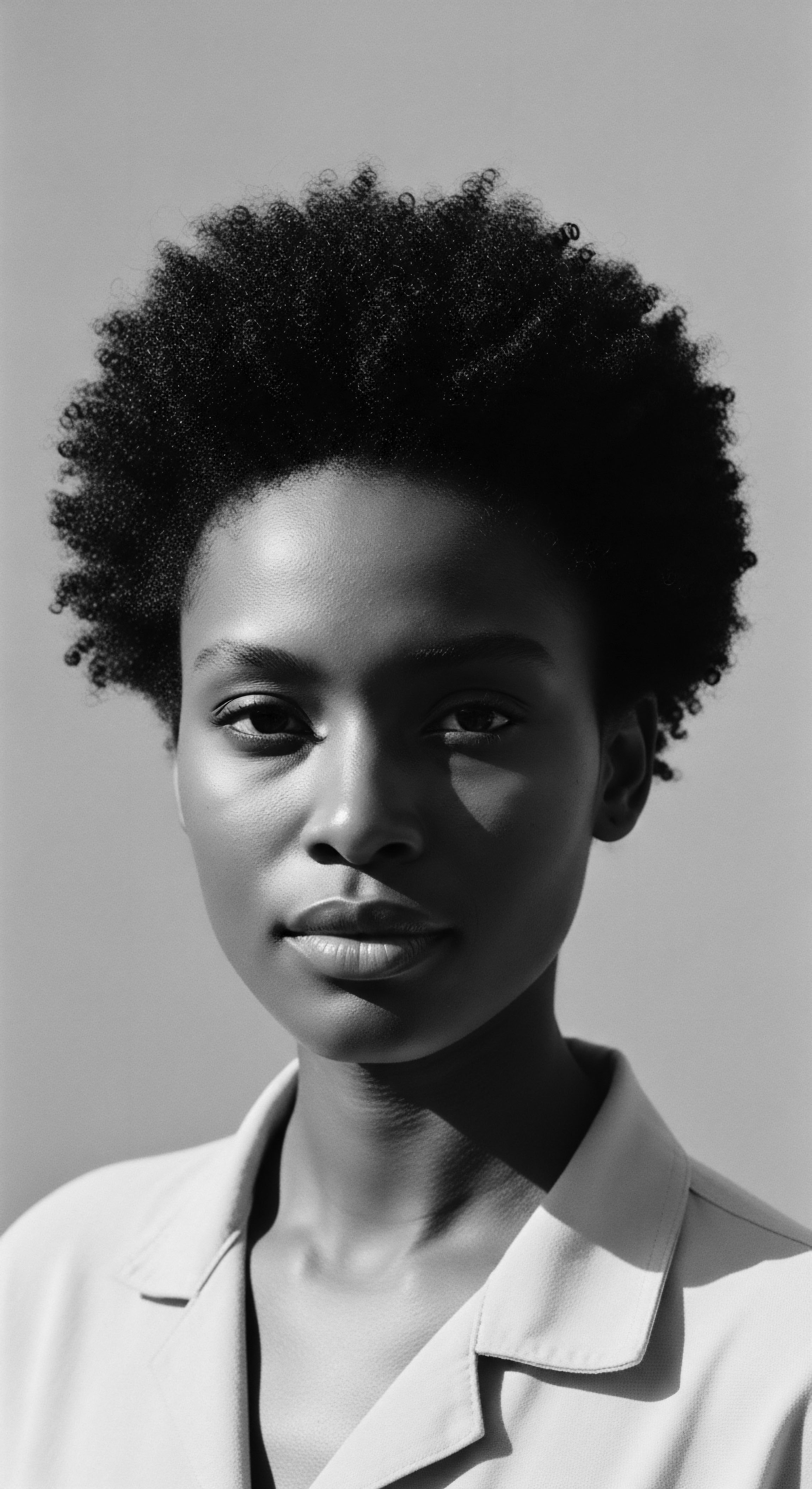
Roots
Consider, for a moment, the hair upon one’s head. It is not simply a biological expression, a collection of protein filaments emerging from the scalp. For Black and mixed-race individuals, and indeed for all who carry the legacy of textured strands, this hair is a living archive, a scroll of ancestral memory, and a quiet testament to unbroken lineage.
Its very existence, its coil and curve, carries within it the echoes of forgotten empires, the whispers of ancient rituals, and the indelible marks of journeys across oceans and through time. When we consider how historical policies concerning hair shaped Black identity, we are delving into a profound dialogue with this living heritage, a conversation that unfurls through the centuries, revealing not just suppression, but remarkable acts of reclamation and beauty.
The earliest known forms of human haircare and styling in African societies were not trivial acts of vanity; they were profound statements of identity, status, spirituality, and tribal affiliation. Hair was braided, coiled, twisted, and adorned with natural elements—clays, oils, cowrie shells—each style a language unto itself, communicating wisdom, marital status, or readiness for battle. These practices, passed down through generations, solidified a reverence for hair as a vital aspect of self and community, a bond woven directly into the fabric of daily life. The inherent strength and versatility of textured hair lent itself to these intricate expressions, demonstrating a deep, intuitive understanding of its unique qualities long before modern science articulated its specific anatomical structures.

The Helix Unveiled
At its elemental heart, textured hair, from the softest wave to the most tightly coiled strand, shares common biological foundations with all human hair, yet its distinctive morphology sets it apart. The elliptical shape of the follicle, the way the keratin bundles align, and the distribution of disulfide bonds contribute to its characteristic curl patterns. These very features, now understood through precise scientific lens, were the same attributes that ancient African hands understood intuitively, learning how to manipulate and adorn them with a wisdom born of generations of observation. This intrinsic design allowed for the resilience and versatility that became both a source of pride and, tragically, a target for policies seeking to dismantle identity.
The intrinsic design of textured hair allowed for the resilience and versatility that became both a source of pride and, tragically, a target for policies seeking to dismantle identity.
The language we use to describe textured hair today, while often influenced by more recent classification systems, can still connect us to this deep past. Traditional African societies possessed their own vocabularies for hair types and styles, often tied to specific cultural meanings. The very term ‘kinky’ or ‘coily,’ while sometimes used dismissively in Eurocentric frameworks, points to the hair’s natural inclination to form tight, spring-like structures, a quality that facilitated many of the protective and symbolic styles of antiquity. Understanding its growth cycles, from the active anagen phase to the resting telogen phase, further informs why certain traditional practices, such as gentle handling and moisture retention, were so universally beneficial across diverse ancestral hair traditions.

How Did Early Colonial Policies Shape Perceptions of Hair?
As colonial powers asserted dominance, a deliberate dismantling of African cultural practices began, and hair became a significant battleground. Policies, whether overt legal statutes or insidious social dictates, sought to strip enslaved and colonized Africans of their original identities, replacing them with a subjugated self. The natural styles, once symbols of royalty and community, were often deemed uncivilized, unkempt, or even dangerous. This was a calculated psychological weapon, aiming to sever the individual from their ancestral roots by devaluing a tangible, visible marker of their heritage.
In the brutal transition of the transatlantic slave trade, the communal rituals of hair care were disrupted, and the very hair that had been a source of pride often became a symbol of degradation. Heads were shaved or roughly treated, not for hygiene alone, but to erase identity, to dehumanize. The meticulous, time-consuming care that had characterized pre-colonial African hair practices was replaced by conditions that made such care impossible, fostering a pervasive narrative that African hair was inherently unruly or problematic. This manufactured perception laid foundational groundwork for subsequent policies that would continue to police and punish Black hair.

Ritual
The ritual of hair care, in its truest ancestral sense, extended far beyond mere hygiene; it was a sacred practice, a communal bonding experience, and a profound act of self-definition. From the rhythmic sound of combs tracing patterns through coils under the shade of a baobab tree to the tender application of herbal oils passed down through maternal lines, these traditions fortified communal ties and preserved cultural memory. When historical policies sought to suppress Black identity, they often targeted these very rituals, attempting to sever the living connection between individuals and their heritage.
Consider the infamous Tignon Laws enacted in colonial Louisiana during the late 18th century. These policies mandated that Black women, particularly those of mixed heritage who often wore elaborate and striking hairstyles, cover their hair with a tignon or head-wrap when in public. The stated reason was to control their perceived attractiveness and social status, which was seen as a threat to the established racial hierarchy. Yet, in an act of profound resilience and cultural defiance, many Black women transformed the mandated tignon into an even grander expression of style and adornment.
They used vibrant fabrics, intricate tying methods, and added jewels, turning a symbol of oppression into an even bolder declaration of beauty and selfhood. This historical example powerfully illuminates how a policy intended to diminish identity ironically spurred a creative reaffirmation of heritage (Giddings, 1984).

Were Hair Policies Tools of Assimilation?
Beyond outright legal mandates, social pressures and institutional policies operated as powerful, often subtle, mechanisms of assimilation. In post-slavery America, and later during the Jim Crow era, schools, workplaces, and public spaces often enforced unspoken, or sometimes explicit, grooming codes that favored straight hair, mirroring Eurocentric beauty ideals. This meant that Black individuals, particularly women, faced immense pressure to chemically straighten their hair or wear wigs to conform, often at great physical and psychological cost. The ‘hot comb’ and chemical relaxers, while appearing to offer choice, became instruments of conformity born from a discriminatory environment.
Discriminatory grooming codes, whether explicit or unspoken, pressured Black individuals to conform to Eurocentric beauty ideals, turning hair into an instrument of societal assimilation.
The impact extended deeply into families and communities. Generations learned that their natural hair was ‘unprofessional’ or ‘messy,’ internalizing messages that undermined their self-worth. This created a profound disconnect from their own ancestral hair traditions and the inherent beauty of their textured strands. The art of styling and defining natural hair, once a vibrant expression of identity, was driven underground or practiced within the confines of private homes, where it remained a cherished act of family and community bonding, safeguarding a heritage under siege.

Ancestral Techniques and Their Endurance
Despite the pressures of assimilation, many traditional styling techniques and tools persisted, often adapted or reinterpreted. Braiding, for instance, a technique with roots stretching back thousands of years across various African cultures, continued to be a fundamental method for managing and adorning textured hair.
- Cornrows ❉ Originating in ancient African agricultural societies, where patterns often mimicked crop rows, cornrows provided a low-manipulation, protective style that could last for weeks, often carrying social or spiritual meanings.
- Twists ❉ A versatile technique used in many West African cultures, twists served not only as a styling method but also as a foundation for other elaborate styles, emphasizing the natural curl pattern.
- Locs ❉ Though gaining mainstream popularity more recently, locs have been a part of African and diasporic cultures for millennia, symbolizing spiritual devotion, wisdom, and an unwavering connection to natural hair. Their formation is a slow, patient process, mirroring the enduring nature of ancestral wisdom.
Traditional tools, simple yet effective, like wooden combs carved for the specific task of detangling dense coils, or natural oils and butters harvested from the earth, continued to be preferred over harsh chemical alternatives in many households. These tools and techniques were not just about aesthetics; they were about maintaining hair health, about reducing breakage, and about affirming the resilience of textured hair itself in the face of policies designed to diminish it.
| Aspect of Hair Heritage Symbolism of Hair |
| Traditional/Ancestral Practice Status, tribal identity, spirituality, beauty |
| Impact of Assimilative Policies Dehumanization, devaluation, pathologizing of natural hair |
| Aspect of Hair Heritage Hair Care Rituals |
| Traditional/Ancestral Practice Communal bonding, meticulous care with natural ingredients |
| Impact of Assimilative Policies Disruption, forced neglect, shift to chemical alteration |
| Aspect of Hair Heritage Styling Techniques |
| Traditional/Ancestral Practice Intricate braids, twists, locs reflecting culture |
| Impact of Assimilative Policies Pressure to straighten, conform to Eurocentric ideals |
| Aspect of Hair Heritage Tools and Products |
| Traditional/Ancestral Practice Natural combs, plant-based oils and butters |
| Impact of Assimilative Policies Introduction of harsh chemicals, hot tools for straightening |
| Aspect of Hair Heritage Policies aimed to sever a connection to heritage, yet resilience and adaptation kept traditions alive. |

Relay
The effects of historical hair policies on Black identity did not vanish with the abolition of overt slavery or the dismantling of Jim Crow laws. Instead, they adapted, shifted shape, and relayed their influence through generations, often manifesting as internalized biases or implicit societal expectations. The relay of these historical burdens became evident in workplace discrimination, school dress codes, and even in the mainstream beauty industry, which for decades largely ignored or misrepresented textured hair. This historical weight compelled Black individuals to continue the fight for hair freedom, transforming what began as individual acts of defiance into collective movements for cultural recognition and legislative protection.
One salient example of this enduring relay is found in the economic impact. The push for straight hair created a lucrative market for relaxers, wigs, and heat styling tools, often at the expense of products that celebrated and nourished natural Black hair. Black entrepreneurs, however, recognizing this unmet need and drawing from ancestral knowledge, began to forge their own paths. Madam C.J.
Walker, often cited for her hair product empire in the early 20th century, stands as a complex figure in this narrative; while some of her products aimed at ‘straightening,’ they also represented economic independence and self-care within a hostile environment. Her innovations, though sometimes controversial in retrospect regarding the products’ effect, helped to establish a foundational legacy of Black hair entrepreneurship, emphasizing the autonomy in hair care decisions even when dictated by prevailing social standards.

What Is the Enduring Influence on Professional Spaces?
The professional arena has long been a front line where the legacy of historical hair policies confronts modern Black identity. For decades, Black individuals, particularly women, faced unspoken, yet powerful, mandates to straighten their hair to be perceived as ‘professional’ or ‘competent.’ Natural styles like braids, locs, and afros were often deemed ‘distracting’ or ‘unprofessional,’ leading to discrimination in hiring, promotions, and daily interactions. This implicit bias forced many into a difficult choice ❉ conform to Eurocentric grooming standards or risk their economic livelihoods.
Research consistently shows this discriminatory pattern. A 2019 study, for instance, revealed that Black women with natural hairstyles were perceived as less professional and less competent than Black women with straightened hair, especially in industries with conservative dress codes (Dover, 2019). This finding underscores the deep-seated nature of these biases, demonstrating how historical devaluations of Black hair persist in contemporary settings, influencing perceptions and opportunities. The struggle for hair freedom in professional contexts is a direct continuation of the fight against policies that sought to control Black bodies and identities.

Legislative Acts for Hair Freedom
The persistence of hair discrimination eventually spurred legislative action, a clear sign that the historical policies continued to exert a tangible, negative impact. The CROWN Act (Creating a Respectful and Open World for Natural Hair) is a legislative effort to combat this discrimination by prohibiting discrimination based on hair texture and protective hairstyles associated with race. This legislation, first passed in California in 2019 and now adopted by numerous states, represents a crucial step in dismantling the lingering effects of historical hair policies.
The CROWN Act, in its essence, acknowledges that hair, particularly textured hair, is inextricably linked to racial and cultural identity. It is a recognition that denying someone employment or educational opportunities based on their natural hair is a form of racial discrimination.
- Acknowledge Heritage ❉ The Act directly affirms that hairstyles like braids, locs, twists, and afros are integral to Black heritage and racial identity, moving beyond simple aesthetic preference.
- Protect Identity ❉ It provides legal protection for individuals to wear their natural hair without fear of punitive measures in schools or workplaces, effectively reversing the historical trajectory of hair policing.
- Foster Inclusion ❉ By challenging long-held biases, the CROWN Act seeks to create more inclusive environments where natural hair is celebrated, not discriminated against, paving the way for a more equitable future.
The ongoing push for national adoption of the CROWN Act demonstrates that the legacy of historical hair policies is still a lived reality for many. It is a collective effort to relay a new message ❉ one of acceptance, cultural pride, and the fundamental right to express one’s identity freely, from the root of the strand to its very tip.

Reflection
As the sun sets on this exploration, a profound truth remains ❉ the policies enacted through history, insidious in their design to diminish Black identity, could not extinguish the innate power and profound beauty of textured hair. Instead, they forged an even deeper, more resilient connection to ancestral heritage. Every coil, every strand, has borne witness to oppression, yet also to unwavering spirit.
The story of Black hair is not merely one of survival; it is a vibrant narrative of defiance, adaptation, and glorious return. It is the very ‘Soul of a Strand’ laid bare, revealing its living essence as a continuous, breathing archive of resilience.
From the meticulous artistry of ancient African coiffeurs to the contemporary movements advocating for hair freedom, the journey of textured hair is a testament to an enduring legacy. It stands as a vibrant symbol, communicating stories of struggle and triumph, innovation and steadfast tradition. This hair, once a target of control, has become an undeniable declaration of self-worth and a sacred link to generations past. Its history is our shared inheritance, a reminder that the most authentic expressions of self, deeply rooted in ancestral wisdom, can never be truly severed.

References
- Giddings, Paula. When and Where I Enter ❉ The Impact of Black Women on Race and Sex in America. William Morrow, 1984.
- Dover, Stephanie, et al. “Hair Bias in the Workplace ❉ Perceived Professionalism of African American Women’s Hairstyles.” Social Psychological and Personality Science, vol. 10, no. 8, 2019, pp. 1022-1031.
- Byrd, Ayana, and Lori Tharps. Hair Story ❉ Untangling the Roots of Black Hair in America. St. Martin’s Press, 2001.
- Mercer, Kobena. Welcome to the Jungle ❉ New Positions in Cultural and Ethnic Studies. Routledge, 1994.
- Banks, Ingrid. Hair Matters ❉ Beauty, Power, and Black Women’s Consciousness. New York University Press, 2000.
- Patton, Tracey. African American Hair Story ❉ A Social and Cultural History. Rowman & Littlefield Publishers, 2006.
- hooks, bell. Black Looks ❉ Race and Representation. South End Press, 1992.
